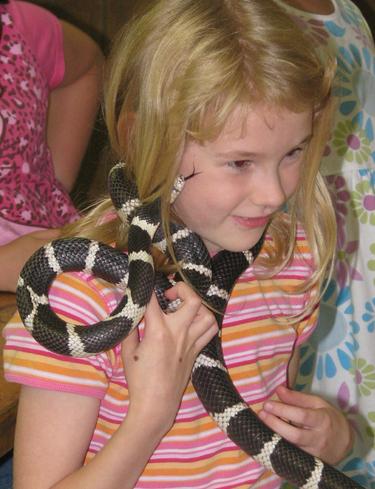July 14, 2009
Big Snakes Update
The 17 foot long snake sighted in the Rumford, Maine, canal has not been caught or found dead, as of July 14, 2009.
One unique explanation for how such big snakes get into the state of Maine was expressed recently by John Ford Sr., a retired game warden, Waldo County Sheriff and Chief Deputy. Speaking about the Rumford snake, Ford wrote on July 13: “As of this writing, whether this giant creature actually exists in the drainage pipes of Rumford has yet to be determined….[I]n the past, there have been a few instances of large snakes riding into our state, secured undetected inside trailer-trucks.”
Ford’s honest, home-spun story that follows (see “Memories from a Game Warden’s Diary: The snake“) is typical of the unspoken “snake fear factor” that does exist in a few people who are in the game warden business.
Meanwhile, in Rumford, elsewhere snakes are “hot.” The man who was asked about the canal snake has shown up in an educational program in the town.

Terry Karkos/Lewiston Sun Journal
Rob “The Snakeman” White, of Mexico, Maine, teaches children and adults about his pet snakes on the afternoon of July 10th, during his educational program for the children’s summer reading program at Rumford Public Library. White is fashionably wearing a ball python around his neck and another around his left arm while displaying Zorro, his California king snake (also seen below with one of the demonstration’s attendees, Erin Landry).

Traveling to Pennsylvania, there are new reports of another large snake out and about.
On July 6, 2009 around noon, an 8-to-10-foot snake was seen slithering across Snowball Drive in Levittown, Bucks County, Pennsylvania, reported Peter Mucha in the Philadelphia Inquirer. Or at least that’s what a witness told police.
In June of 2007, in Bristol, about five miles south, a nine-foot albino python was caught, and a 12-foot boa constrictor or python was reportedly seen hiding in a crawl space and possibly eating newborn kittens, according to the melodramatic newspaper accounts at the time.
The latest Pennsylvania snake, described as resembling a python, went into a small wooded area near the intersection with Shell Flower Road, perhaps headed toward Mill Creek, according to the eyewitness.
We went out and looked around and didn’t see the snake. Didn’t even see a slither mark. We had one sighting of it.
Maybe it’s possible somebody is going to come home from work at the end of the day and find their cage open, but no one has called so far.
Really not much to give you, but our concern is little children and domestic pets.
No chihuahaus missing, or anything like that.
Officer Dan Deacon, Middletown Township Police Department, July 6, 2009.
Deacon added this was the first big-snake sighting reported during his 28 years on the force.
Meanwhile, on Monday, July 13, 2009, in the area of 24th and Payson Avenue in Quincy, Illinois, police were telling folks to be on the lookout for a eight foot boa constrictor that’s on the loose. The Quincy Police Department said the snake has been missing for a couple of weeks. City ordinance requires all owners of any snakes over six feet in length to have a permit from the city.
This summer’s rising interest by the press in big snakes can be traced back to one fatal incident that occurred two weeks ago.

Bruce Ackerman /Ocala Star-Banner
In Oxford, Florida, police remove a Burmese python from a home, where it escaped from a terrarium and strangled a 2-year-old girl in her bedroom on July 1, 2009.
The 2-year-old girl was fatally strangled in her home by her family’s pet python, which was about eight feet long, according to the Orlando Sentinel.
It apparently escaped from a living-room aquarium cage.
Florida officials couldn’t remember another case of of a nonvenomous snake killing anyone.
What has occurred since then is the reflective copycat factor, just as we saw in the “Summer of the Sharks” and the “Summer of the Gators.” Fatal attacks on humans are followed by the news media noting and mentioning almost every sighting and encounter with the specific type of animal under the microscope, whether there are actual increases in the incidents or not. The media variable appears to overemphasize the true number of events.
 About Loren Coleman
About Loren Coleman
Loren Coleman is one of the world’s leading cryptozoologists, some say “the” leading living cryptozoologist. Certainly, he is acknowledged as the current living American researcher and writer who has most popularized cryptozoology in the late 20th and early 21st centuries.
Starting his fieldwork and investigations in 1960, after traveling and trekking extensively in pursuit of cryptozoological mysteries, Coleman began writing to share his experiences in 1969. An honorary member of Ivan T. Sanderson’s Society for the Investigation of the Unexplained in the 1970s, Coleman has been bestowed with similar honorary memberships of the North Idaho College Cryptozoology Club in 1983, and in subsequent years, that of the British Columbia Scientific Cryptozoology Club, CryptoSafari International, and other international organizations. He was also a Life Member and Benefactor of the International Society of Cryptozoology (now-defunct).
Loren Coleman’s daily blog, as a member of the Cryptomundo Team, served as an ongoing avenue of communication for the ever-growing body of cryptozoo news from 2005 through 2013. He returned as an infrequent contributor beginning Halloween week of 2015.
Coleman is the founder in 2003, and current director of the International Cryptozoology Museum in Portland, Maine.
Email • Facebook • Twitter •
Filed under Animal Escapees, Breaking News, Cryptomundo Exclusive, Cryptotourism, CryptoZoo News, Eyewitness Accounts, Giant Cryptid Reptiles, Media Appearances, Out of Place, Pop Culture, Weird Animal News



